- Home
- Colleen McCullough
On, Off Page 3
On, Off Read online
Page 3
“What makes the job so good?” Carmine asked, aware that his belly was rumbling. Everyone at the Hug had been fed, but thus far Carmine had missed out on breakfast and lunch.
“I’m the boss,” Cecil said. “When I worked over in P.P. I was just one more shit shoveler. At the Hug, animal care is mine. I like it, specially ’cos we got the monkeys. Dr. Chandra — they his, really — knows I am the best monkey man on the east coast, so he leaves them to me. I even get to put them in the chair for their sessions. They crazy about their sessions.”
“Don’t they like Dr. Chandra?” Carmine asked.
“Oh, sure, they like him fine. But me, they love.”
“Do you ever empty the refrigerator, Cecil?”
“Sometimes, not much. If Otis goes on vacation, we hire a man off of P.P.’s plant physical reserves. Otis don’t work this floor with me much — he the upstairs man. Gets to change the lightbulbs an’ dispose of the hazardous waste too. I can mostly manage this floor’s animal care on my own, ’cept for bringing the cages up an’ down from the other floors. Our animals get clean cages Mondays through Fridays.”
“They must hate the weekends,” said Carmine solemnly. “If Otis doesn’t work with you much, how do you clean the cages?”
“See that door there, Lieutenant? Goes to our cage washer. Automated like a fancy car wash, but better. The Hug got everything, man, everything.”
“Getting back to the refrigerator. When you do empty it, Cecil, what size are the bags? Is it strange to see bags as big as the — er —?”
Cecil thought, his fine head to one side, the monkey seizing the chance to look behind his ear. “Ain’t strange, Lieutenant, sir, but you best ask Otis, he the expert.”
“Did you notice anyone yesterday putting bags in the fridge who doesn’t usually do that?”
“Nope. The researchers mostly bring their bags down theirselves after Otis an’ me are gone for the day. Technicians bring bags down too, but small. Rat bags. Only technician brings down big bags is Mrs. Liebman from the O.R., but not yesterday.”
“Thanks, Cecil, you’ve been a great help.” Carmine extended his hand to the monkey. “So long, Jimmy.”
Jimmy held out his hand and shook Carmine’s gravely, his big round amber eyes so full of awareness that Carmine felt his skin prickle. They looked so human.
“Just as well you a man,” Cecil said, laughing, escorting Carmine to the door with Jimmy on his hip.
“Why’s that?”
“All six of my babies are male, an’ man, they hate women! Can’t stand a woman in the same room.”
Don Hunter and Billy Ho were working together on some sort of Rube Goldberg apparatus they were assembling out of electronic components, Plexiglass extrusions and a pump designed to take a small glass syringe. Two mugs of coffee stood nearby, looking cold and scummy.
That they had both been trained in the armed services was plain the moment Carmine uttered the word “Lieutenant.” They sprang away from the gadget and stiffened to attention. Billy was of Chinese ancestry; he had become an electronics engineer in the U.S. Air Force. Don was an Englishman from what he called “the north” and had served in the Royal Armoured Corps.
“What’s that gizmo?” Carmine asked.
“A pump we’re fitting to some circuitry so it only delivers one-tenth of one em-el every thirty minutes,” said Billy.
Carmine picked up the mugs. “I’ll bring you some fresh from that urn I saw in the hall if you’ll let me have a mug of it and shovel in plenty of sugar.”
“Gee, thanks, Lieutenant. Take the whole sugar jar.”
If he didn’t get some sugar into his system, Carmine knew, his attention would start to flag. He detested very sweet coffee, but it stopped his belly growling. And over it, he could settle to a friendly chat. They were loquacious men, eager to explain their jobs and very keen to assure Carmine that the Hug was great. Billy was the electronics engineer, Don the machinist. Between the two of them they painted Carmine a fascinating picture of a life largely spent designing and building things no sane person could envisage. Because researchers, Carmine learned, were not sane persons. They were mostly pain-in-the-ass maniacs.
“A researcher can fuck up a carload of steel balls,” Billy said. “They might have brains the size of Madison Square Garden and win Nobel Prizes all over the shop, but man, can they be dumb! Know what their main problem is?”
“It’ll be a help,” said Carmine.
“Common sense. They got fuck-all common sense.”
“Yoong Billy is raht abaht thaht,” said Don. Or at least it sounded as if that was what he had said.
When he departed Carmine was convinced neither Billy Ho nor Don Hunter had left two pieces of woman in the dead animal refrigerator. Though whoever had was not lacking in common sense.
Neurophysiology lived on the next floor up, the second. It was headed by Dr. Addison Forbes, who had two colleagues, Dr. Nur Chandra and Dr. Maurice Finch. Each man had a spacious laboratory and a roomy office; beyond Chandra’s suite was the operating room and its anteroom.
The animal room was large and held cages containing two dozen big male cats as well as cages for several hundred rats. He started there. Each cat, he noted, lived in a spotlessly clean cage, dined on canned food as well as kibble, and did its business in a deep tray filled with aromatic cedar shavings. They were friendly beasts, neither spooked nor depressed, and seemed quite oblivious to the presence of half a tennis ball on their heads. The rats lived in deep plastic bins filled with finer shavings through which they dived like dolphins through the sea. In, out, around and about, curling their little hand-like paws around the steel gratings covering their bins with a great deal more joy than human prisoners grabbed the bars of their cells. The rats, Carmine saw, were happy.
His tour guide was Dr. Addison Forbes, who was not happy.
“The cats belong to Dr. Finch and Dr. Chandra. The rats are Dr. Finch’s. I don’t have any animals, I’m a clinician,” he said. “Our appointments are excellent,” he droned on as he conducted his guest down the hall between the animal room and the elevators. “Each floor has a male and a female rest room” — he pointed — “and a coffee urn that our glass washer, Allodice, takes care of. The cylindered gases live in this closet, but oxygen is piped in, as are coal gas and compressed air. The fourth line of pipe is for vacuum suction. Particular attention was paid to grounding and copper shielding — we work in millionths of one volt, and that means amplification factors that make interference a nightmare. The building is air-conditioned and the air is filtered minutely, hence the no smoking regulation.”
Forbes ceased the drone to look surprised. “The thermostats actually work.” He opened a door. “Our reading and conference room. Which completes the floor. Shall we go to my office?”
Addison Forbes, Carmine had decided within a very few moments, was a complete neurotic. He sported a sinewy, gaunt leanness that suggested an exercise freak with vegetarian tendencies, was about forty-five years of age — the same age as the Prof — and not much to look at if you were a movie director searching for a new star. Facial tics and abrupt, meaningless gestures with his hands larded his conversation. “I had a most severe coronary exactly three years ago,” he said, “and it’s a miracle that I survived.” Clearly it obsessed him, not unusual in medical doctors, who, Patrick had told him, never thought that they could die, and became atrocious patients when mortality thrust itself upon them. “Now I jog the five miles between the Hug and my home every evening. My wife drives me here in the morning and picks up yesterday’s suit. We don’t need two cars anymore, a welcome economy. I eat vegetables, fruit, nuts and an occasional piece of steamed fish if my wife can find some that’s genuinely fresh. And I must say that I feel wonderful.” He patted his belly, so flat that it caved in. “Good for another fifty years, ha ha!”
Jeez! thought Carmine. I think I’d rather be dead than give up the greasies at Malvolio’s. Still, it takes all kinds. “How often do you
or your technician take dead animals down to the first-floor refrigerator?” he asked.
Forbes blinked, looked blank. “Lieutenant, I have already told you that I am a clinician! My research is clinical, I don’t use experimental animals.” His brows tried to go in opposite directions. “Even if I have to say so myself, I have a genius for giving each individual patient exactly the right anticonvulsant medication. It is a widely abused field — can you imagine the gall of a fool general practitioner taking it upon himself to prescribe anticonvulsants? He diagnoses some poor patient as idiopathic and stuffs the poor patient full of Dilantin and phenobarb, when all the time the poor patient has a temporal lobe spike you could impale yourself on! Tch! I run the epilepsy clinics at the Holloman Hospital, several other hospitals, and I’m in charge of the Holloman Hospital EEG unit attached to the epilepsy clinic. I don’t concern myself with ordinary EEGs, you understand. There is another unit for Frank Watson and his neurological and neurosurgical minions. What I’m interested in are spikes, not delta waves.”
“Uh-huh,” said Carmine, whose eyes had begun to glaze halfway through this semi-diatribe. “So you definitely don’t ever dispose of dead animals?”
“Never!”
Forbes’s technician, a nice girl named Betty, confirmed this. “His work here concerns the level of anticonvulsant medications in the bloodstream,” she explained in words Carmine had a hope of understanding. “Most doctors overmedicate because they don’t keep track of drug levels in the bloodstream in long-term disorders like epilepsy. He’s also the one the pharmaceutical companies ask to try new drugs out. And he has an uncanny instinct for what a particular patient needs.” Betty smiled. “He’s weird, really. Art, not science.”
And how, Carmine wondered as he went in search of Dr. Maurice Finch, do I get out of being buried under medical gobbledygook?
But Dr. Finch wasn’t the man to bury anyone under medical gobbledygook. His research, he said briefly, concerned movement of things called sodium and potassium ions through the wall of the nerve cell during an epileptic seizure.
“I work with cats,” he said, “on a long-term basis. Once their electrodes and perfusion cannulae are implanted in their brains — under general anesthesia — they suffer no trauma at all. In fact, they look forward to their experimental sessions.”
A gentle soul, was Carmine’s verdict. That did not put Finch out of the murder stakes, of course; some brutal killers seemed the gentlest of souls when you met them. At fifty-one he was older than most of the researchers, so the Prof had said; research was a young man’s game, apparently. A devout Jew, he and his wife, Catherine, lived on a chicken farm; Catherine bred for the kosher table. Her chickens kept her busy, Finch explained, as they had never managed to have any children.
“Then you don’t live in Holloman?” he asked.
“Just within the county line, Lieutenant. We have twenty acres. Not all chickens! I’m an ardent cultivator of vegetables and flowers. I have an apple orchard and several glasshouses too.”
“Do you bring your dead animals downstairs, Dr. Finch, or does your technician — Patricia? — do that?”
“Sometimes I do it, sometimes Patty does,” Finch said, his wide grey eyes looking at Carmine without guilt or unease. “Mind you, my kind of work means I don’t do a lot of sacrificing. When I finish with a pussycat, I take the electrodes and cannulae out, castrate him, and try to give him to someone as a pet. I don’t harm him, you see. However, a cat may develop a brain infection and die, or simply die of natural causes. Then they go downstairs to the refrigerator. Mostly I take them — they’re heavy.”
“How often does a dead cat happen, Doctor?”
“It’s hard to say. Once a month, maybe only every six months.”
“I see you take good care of them.”
“One cat,” said Dr. Finch patiently, “represents an investment of at least twenty thousand dollars. He has to come with papers that satisfy the various authorities, including the A.S.P.C.A. and the Humane Society. Then there is the cost of his upkeep, which has to be first-class or he doesn’t survive. I need healthy cats. Therefore a death is unwelcome, not to say exasperating.”
Carmine moved on to the third researcher, Dr. Nur Chandra.
Who took his breath away. Chandra’s features were cast in a patrician mold, his lashes were so long and thick that they seemed false, his brows were finely arched and his skin the color of old ivory. His wavy black hair was cut short, in keeping with his European clothes; except that a master cut the hair, and the clothes were cashmere, vicuña, silk. A buried memory unearthed itself: this man and his wife were known as the handsomest couple in all of Chubb. Ah, he had Chandra now! The son of some maharajah, rolling in riches, married to the daughter of another Indian potentate. They lived on ten acres just inside the Holloman County line, together with an army of servants and several children who were tutored at home. Apparently the swanky Dormer Day School was not swanky enough. Or might give the kids too many American ideas? They enjoyed diplomatic immunity, quite how, Carmine didn’t know. That meant kid gloves, and pray he wasn’t the one!
“My poor Jimmy,” said Dr. Chandra, voice sympathetic but not oozing the tenderness Cecil’s did when speaking of Jimmy.
“Give me Jimmy’s story, please, Doctor,” Carmine said, gaze riveted on another monkey, its legs crossed nonchalantly, seated in a complicated Plexiglass chair inside an enormous box with its door open. The beast was minus its tennis ball hat, revealing a pink mass of dental cement in which was embedded a bright green female connector. A bright green male plug had been inserted into it, and a thick, twisted cable of wires in many colors ran to a panel on the box wall. Presumably the panel connected the monkey to a lot of electronic equipment in nineteen-inch racks around the box.
“Cecil called me yesterday to tell me he’d found Jimmy dead when he went in to see the monkeys after lunch,” the researcher said in the most pear-shaped English accent Carmine had ever heard. Nothing in common with Miss Dupre’s or Don Hunter’s accents, different though they were from each other. Amazing that such a tiny country had so many accents. “I went downstairs to see for myself, and I swear to you, Lieutenant [another leftenant], that I deemed Jimmy dead. No pulse, no respiration, no heart sounds, no reflexes, both pupils dilated. Cecil asked me if I wished Dr. Schiller to perform an autopsy, but I declined. Jimmy hasn’t had his electrodes implanted for long enough to have been of any experimental value to me. But I told Cecil to leave him be, that I’d check again at five, and if he hadn’t changed, I’d pop him in the refrigerator myself. Which is what I did.”
“What about this guy?” Carmine asked, pointing at the monkey, which bore the same expression as Abe when dying for a cigarette.
“Eustace? Oh, he’s of immense value! Aren’t you, Eustace?”
The monkey transferred its gaze from Carmine to Dr. Chandra, then grinned ghoulishly. You are one arrogant bastard, Eustace, thought Carmine.
Chandra’s technician was a young man named Hank, who took Carmine to the O.R.
Sonia Liebman greeted him in the anteroom, describing herself as the O.R. technician. The anteroom was given over to shelves of stores to do with surgery; it also contained two autoclaves and a formidable-looking safe.
“For my restricted drugs,” Mrs. Liebman said, indicating the safe. “Opiates, Pentothal, potassium cyanide, a bunch of nasties.” She handed Carmine a pair of canvas bootees.
“Who knows the combination?” he asked, putting them on.
“I do, and it is not written down anywhere,” she said firmly. “If they have to carry me out feet first, they’ll have to bring in a safe-cracker. Share a secret, and it’s no secret.”
The O.R. itself looked like any other operating room.
“I don’t operate under fully sterile conditions,” she said, leaning her rump on the operating table, which was an expanse of clean linen savers and had a curious apparatus mounted at one end, all aluminum sticks, frames, knobs geared down to Vernier
scale. She herself was clad in a clean boilersuit — ironed — and canvas bootees. An attractive woman of about forty, he decided, slim and businesslike. Her dark hair was drawn back in a no-nonsense bun, her eyes were dark and intelligent, and her lovely hands were marred by nails cut very short.
“I thought an O.R. had to be sterile,” he said.
“Scrupulous cleanliness is far more important, Lieutenant. I’ve known O.R.s more sterile than a zapped fruit fly, but no one ever really cleaned them.”
“So you’re a neurosurgeon?”
“No, I’m a technician with a master’s. Neurosurgery is a man’s field, and they give women neurosurgeons hell. But at the Hug I can do what I love to do without that kind of trauma. Due to the size of my patients, it’s very high-powered neurosurgery. See that? My Zeiss operating microscope. They don’t have one in the Chubb neurosurgery O.R.s, not one,” said the lady with great satisfaction.
“You operate on what?”
“Monkeys for Dr. Chandra. Cats for him and Dr. Finch. Rats for the neurochemists upstairs, and cats for them too.”
“Do they die on the table often?”
Sonia Liebman looked outraged. “What do you think I am, hamfisted? No! I sacrifice animals for the neurochemists, who don’t often work on live brains. Neurophysiologists work on live brains. That’s the main difference between the two disciplines to me.”
“Uh, what do you sacrifice, Mrs. Liebman?” Tread carefully, Carmine, tread carefully!

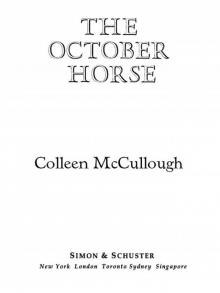 The October Horse: A Novel of Caesar and Cleopatra
The October Horse: A Novel of Caesar and Cleopatra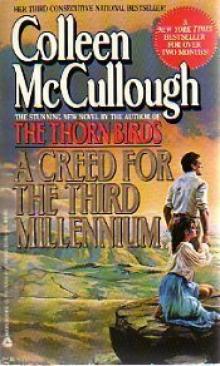 A Creed for the Third Millennium
A Creed for the Third Millennium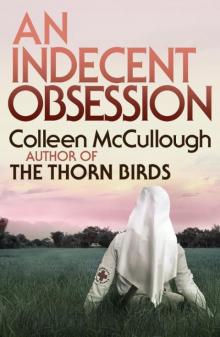 An Indecent Obsession
An Indecent Obsession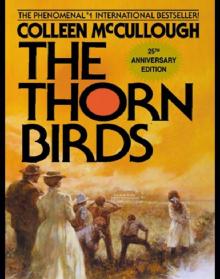 The Thorn Birds
The Thorn Birds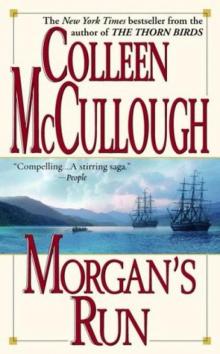 Morgan's Run
Morgan's Run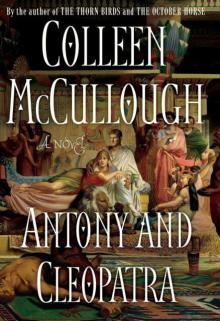 Antony and Cleopatra
Antony and Cleopatra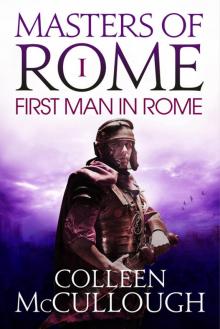 The First Man in Rome
The First Man in Rome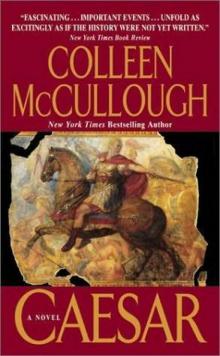 Caesar
Caesar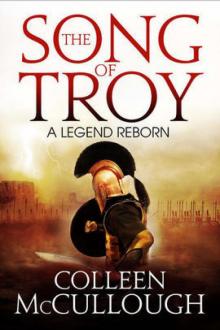 The Song of Troy
The Song of Troy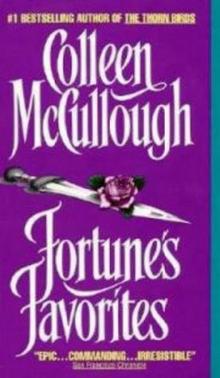 Fortune's Favorites
Fortune's Favorites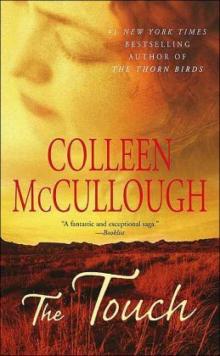 The Touch
The Touch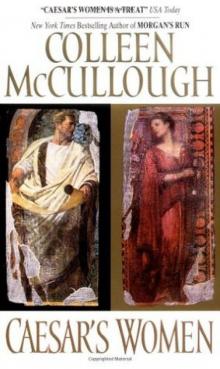 Caesar's Women
Caesar's Women The Independence of Miss Mary Bennet
The Independence of Miss Mary Bennet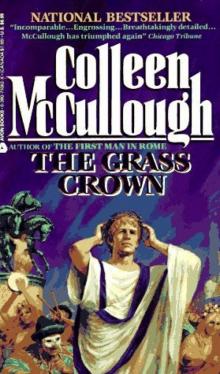 The Grass Crown
The Grass Crown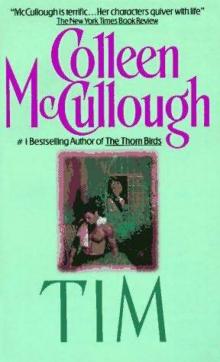 Tim
Tim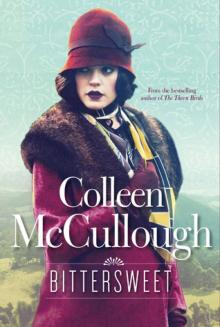 Bittersweet
Bittersweet Angel
Angel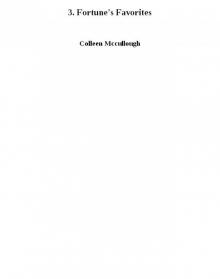 3. Fortune's Favorites
3. Fortune's Favorites Sins of the Flesh
Sins of the Flesh 2. The Grass Crown
2. The Grass Crown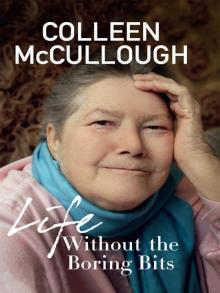 Life Without The Boring Bits
Life Without The Boring Bits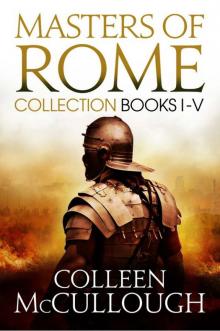 Masters of Rome Boxset: First Man in Rome, the Grass Crown, Fortune's Favourites, Caesar's Women, Caesar
Masters of Rome Boxset: First Man in Rome, the Grass Crown, Fortune's Favourites, Caesar's Women, Caesar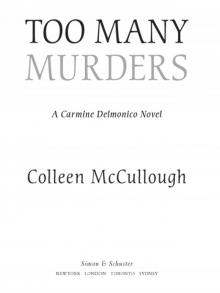 Too Many Murders
Too Many Murders 1. First Man in Rome
1. First Man in Rome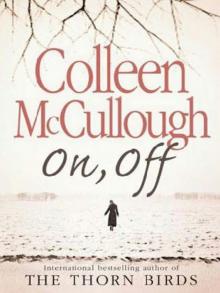 On, Off
On, Off 5. Caesar
5. Caesar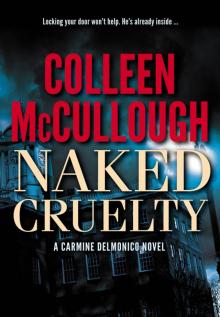 Naked Cruelty
Naked Cruelty 6. The October Horse: A Novel of Caesar and Cleopatra
6. The October Horse: A Novel of Caesar and Cleopatra